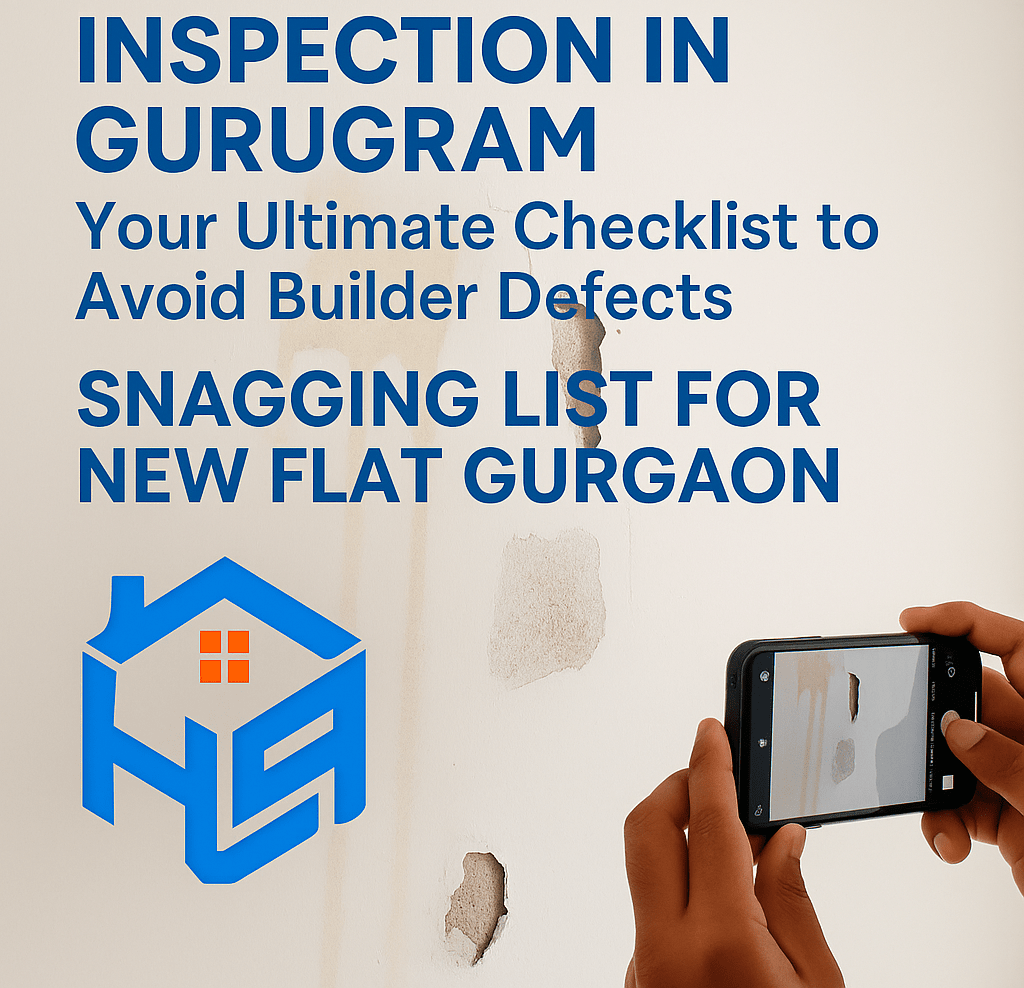Pre-Possession inspection Gurgaon is the first step every homebuyer should take before moving into a new property. Whether you’re buying your dream home or investing in real estate, creating a proper snagging list for new flat Gurgaon ensures you detect builder defects early, avoid hidden repair costs, and enjoy a smooth handover process.
Why a Pre-Possession Inspection Gurgaon is Essential
Think of it as your final quality check, your last line of defense against builder defects. In a bustling real estate market like Gurugram, where properties are delivered at a rapid pace, minor or even significant issues can sometimes slip through the cracks. This definitive guide will equip you with a comprehensive snagging list for your new flat in Gurugram, ensuring a smooth and stress-free handover.
Why is a Pre-Possession Inspection Non-Negotiable in Gurugram?
Gurugram’s real estate landscape is dynamic. While most builders strive for quality, the sheer volume of projects can sometimes lead to oversight. A thorough pre-possession inspection ensures that:
- You get what you paid for: Your hard-earned money deserves a flawless home.
- Hidden defects are uncovered: Many issues aren’t immediately obvious but can become major problems later.
- Repairs are the builder’s responsibility: It’s far easier and cheaper to get defects rectified before you take possession.
- Future legal hassles are avoided: A documented inspection can be a valuable record if disputes arise.
Your Ultimate Pre-Possession Inspection Checklist: A Room-by-Room Guide
Grab a notepad, your phone (for photos!), and perhaps even a friend or a professional inspector. Let’s go through your new Gurugram flat, room by room. Snagging List for New Flat Gurgaon – Complete Checklist.
1. The Entrance & Main Door
- Door Operation: Does the main door open and close smoothly? Does it latch securely?
- Locks & Keys: Are all locks working? Have you received all sets of keys?
- Door Frame: Check for cracks, chips, or damage to the frame.
- Doorbell: Test the doorbell – does it ring clearly?
2. Living & Dining Areas
- Flooring:
- Tiles/Marble: Look for chipped, cracked, or loose tiles. Tap gently – a hollow sound might indicate poor fixing.
- Leveling: Is the floor level? (You can use a small ball or a spirit level).
- Grouting: Is the grout consistent and free from gaps?
- Walls & Ceiling:
- Cracks: Look for hairline cracks or larger structural cracks.
- Dampness/Stains: Check for any signs of water seepage or previous dampness, especially near windows or balconies.
- Paint Finish: Is the paint even? Are there any bubbles, peelings, or rough patches?
- Windows:
- Operation: Do windows open and close smoothly? Are the latches secure?
- Glass Panes: Check for cracks, scratches, or manufacturing defects.
- Sealing: Is the silicone sealing around the window frames intact and leak-proof?
- Electrical Points:
- Sockets & Switches: Test every single socket with a phone charger or a small appliance. Ensure switches work.
- Wiring: While not visible, ensure all switchboards are properly fitted and secure.
Here’s an example of what to look for when inspecting the walls and ceiling:

3. Kitchen
- Countertops:
- Leveling: Is the counter level?
- Cracks/Chips: Look for any damage to the granite or marble.
- Finishing: Is the edge finishing smooth and complete?
- Sink & Faucet:
- Water Flow: Turn on both hot and cold taps – check for adequate pressure and any leaks.
- Drainage: Fill the sink and let it drain completely. Check for blockages or slow drainage.
- Leaks: Inspect under the sink for any signs of leakage.
- Cabinetry (if provided):
- Door Operation: Do cabinet doors open and close smoothly? Are hinges secure?
- Shelving: Are shelves installed correctly and sturdy?
- Finishing: Check for any scratches or damage to the laminate/wood.
- Electrical Points:
- Appliance Points: Test all points for refrigerator, microwave, water purifier, chimney, etc.
- Exhaust Fan Point: If applicable, ensure the provision is there and working.
4. Bedrooms
- Flooring, Walls & Ceiling: (Refer to Living Area checklist – apply the same scrutiny).
- Wardrobe Space (if built-in): Check the internal finishing, door operation, and shelving.
- Doors: Check internal doors for smooth operation, secure latches, and any damage.
- Windows: (Refer to Living Area checklist).
- Electrical Points: Ensure all light fixtures, fan points, and plug points are working.
5. Bathrooms
- Flooring & Walls:
- Tiles: Check for chipped, cracked, or loose tiles. Ensure proper grouting.
- Slope: Is the floor sloping correctly towards the drain to prevent water pooling?
- Sanitary Fittings:
- Commode: Flush multiple times. Check for leaks around the base and ensure proper flushing mechanism.
- Wash Basin: Fill and drain the basin. Check for leaks and proper drainage.
- Taps & Showers: Test all taps (hot and cold) and the showerhead for water pressure and leaks.
- Geyser Point: Check the electrical point and plumbing for the geyser.
- Mirrors & Accessories: Are mirrors securely fixed? Are towel rods, soap dishes, etc., properly installed?
- Exhaust Fan: Test if the exhaust fan is working.
- Drainage: Ensure all floor drains are clear and free of debris.
6. Balcony/Utility Area
- Flooring: Check for cracks, chips, and proper slope for drainage.
- Railing: Ensure the railing is sturdy and securely fixed.
- Drains: Check if balcony drains are clear.
- Water Tap: If a tap is provided, test it for water flow and leaks.
- Electrical Point: If any, test it.
7. Common Areas & External Checks (if applicable to your unit)
- Main Electrical Board: Locate it and ensure it’s securely installed.
- Intercom/Video Door Phone: Test functionality if installed.
- Gas Pipeline: If piped gas is provided, check for proper installation and any visible damage (though professionals will activate this).
- Storage/Utility Closets: Check internal finishing and door operation.
What to Do During the Inspection
- Carry Your Documents: Keep your allotment letter and floor plan handy to cross-verify dimensions and layouts.
- Take Pictures & Videos: Document every single defect, no matter how small. This is your evidence.
- Use a Snagging List: Print this checklist and tick off items as you go. Make detailed notes next to any defects found.
- Involve the Builder’s Representative: Ensure a representative from the builder is present during the inspection. Point out defects directly to them.
- Be Thorough, Not Rushed: Don’t feel pressured to finish quickly. Take your time.
- Don’t Hesitate to Re-Inspect: Once the builder claims to have rectified the issues, schedule a second inspection to verify.
After the Inspection: The Follow-Up
- Submit a Formal List: Compile all your findings into a formal “snagging list” or “punch list” and submit it to the builder in writing, ideally with acknowledgment. Include photos and videos as supporting evidence.
- Set a Timeline: Discuss a reasonable timeline for rectification with the builder.
- Regular Follow-ups: Keep following up with the builder until all issues are resolved to your satisfaction.
When to Consider a Professional Pre-Possession Inspection Service
While this checklist is comprehensive, sometimes a fresh, expert eye can spot things you might miss. In Gurugram, several professional snagging services specialize in pre-possession inspections. They use specialized tools and have extensive experience identifying defects. If you’re short on time, lack confidence in your DIY inspection skills, or dealing with a high-value property, a professional service can be a worthwhile investment.
Conclusion
Your new home in Gurugram is a significant investment, and ensuring its quality before taking possession is paramount. By diligently following this pre-possession inspection Gurugram checklist and creating a detailed snagging list for your new flat Gurugram, you empower yourself to demand the quality you deserve. Don’t rush this vital step – a little effort now can save you a lot of stress and money down the line, paving the way for truly happy homeownership!
Frequently Asked Questions
Find answers to commonly asked questions about our products and services.
